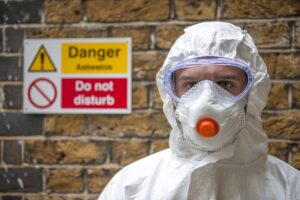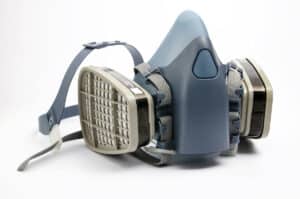Personal Protective Equipment (PPE) is important for workers who encounter hazards like asbestos every day while on the job. Learn which PPEs are appropriate for industrial employees handling airborne toxins like asbestos.

PPE or personal protective equipment is any type of clothes or coverings for laborers that help protect them from excessive levels of exposure to poisonous substances. Almost every industrial, environmental, or construction job brings with it levels of risk. Most work injuries occur when inadequately trained employees contact chemical, radiological, physical, electrical, or mechanical dangers. Take asbestos, for instance. It’s a poisonous mineral found deep underground in rock and soil deposits that can cause lung diseases like mesothelioma. Not long ago, before people knew it was dangerous, it was actually famous for its insulation ability.
For decades, manufacturers used asbestos in reinforcing a number of materials and infrastructure that workers in many different industries still encounter today. When asbestos exists in old, crumbling structures, workers, residents, or even intense weather conditions can cause the spindly poisonous asbestos fibers to become airborne and easily inhaled or ingested. Workers that use the national standard and recommended PPE at their jobs significantly lower their risk of dangerous exposures to asbestos and other hazards while at the workplace.
PPEs can encompass respiratory equipment, face, hands, body, and feet coverings. These can include hard hats, safety glasses, respirators, gloves, shoes, earplugs, coveralls, vests, and full-body suits. Every job will need a specific set of PPEs.
Workers can safely incorporate a range of disposable clothing as personal protective equipment. OSHA suggests that all clothing under this category be made of synthetic fabrics that block tiny asbestos fibers. Synthetic coveralls, respiratory masks, boots, and gloves. The Occupational Health and Safety Administration (OSHA) is a governmental organization from the US Department of Labor. They also recommend workers avoid external pockets and anything Velcro, as these tend to trap spindly asbestos fibers on or inside them. Additionally, shoes and gloves should be thick, leather, or other synthetic material that can’t tear or let in the air easily. This is because the barbed fibers can become airborne and latch on. Also, reinforce shoes or boots with plastic air-tight covers to keep the poisonous dust away.
Besides protective clothing, the most important safety tool industrial workers will need to protect against themselves airborne toxins like asbestos, is, of course, respiratory gear. The Environmental Protection Agency (EPA) does not recommend single-use, disposable paper dust masks for asbestos removal.
Don’t take the cheap shortcut when it comes to safety, because it can cost you later.
The EPA highly suggests the following personal protective equipment when handling asbestos:
OR

When using personal protective equipment on the job, it’s important to maintain these safety methods so PPEs are always performing at optimal levels.
Before stepping onto the job site, employees should fully understand exactly what gear they need to get, when they need it, and how to properly wear, adjust, and remove it. And, they should study the specifications of each article of safety gear so they understand exact strengths and limitations.
OSHA recommends any company or industry that requires the use of personal protective equipment put together a safety program for employees. The program can address the dangers of the job, maintenance, and proper use of all equipment, not just PPEs. The team should be properly and routinely trained in all safety practices and standard operating procedures for optimum safety.
Project managers should thoroughly inspect and test every worksite that has known or suspected asbestos (or other toxins) contamination. For asbestos, managers can take samples of dirt with a test kit and send them to a lab for assessment. Others may find it helpful to hire a certified professional to inspect and remove the property for hazards.
When the project is complete, employees should throw out all disposable PPE before they go home, so they don’t bring the fibers back and potentially pass them on to family members or loved ones. This is how indirect asbestos poisoning occurs. For workers using non-disposable gear, they must make sure to clean and maintain adequately, so that equipment stays in good shape.
Asbestos was outlawed decades ago. While industrial workers should always wear personal protective equipment on the job, there are asbestos laws in place to protect them from negligent exposure to cancer-causing agents like asbestos. It’s the responsibility of the building owner or manager to remove the mineral adequately. This includes any infrastructure, tools, or machinery employees or residents can access.
If you have been affected by mesothelioma and believe it was from asbestos exposure while you were at work, you have legal rights. You may be able to enter litigation against the company responsible.
Jennifer Verta thrives as a digital content writer at Mesothelioma Hub. She has been producing content for clients since before she graduated from the University of Colorado at Denver with a Bachelor of Arts in Communication and a Minor in English Writing. Jen’s mission is to help promote awareness of mesothelioma to as many people as possible by providing only the most up-to-date and accurate content available. When she isn’t cranking the gears at work, Jen can be found snowboarding, hiking, catching live music, or socializing with friends.
EPA. (2021). Asbestos Professionals. Retrieved May 2021, from https://epa.gov/asbestos/asbestos-professionals
EPA. (2021). Safe Work Practices. Retrieved May 2021, from https://epa.gov/asbestos/safe-work-practices
OSHA. (ND). Permissible Practice. Retrieved May 2021, from https://osha.gov/laws-regs/regulations/standardnumber/1910/1910.134
OSHA. (2021) Personal Protective Equipment. Retrieved May 2021, from https://osha.gov/personal-protective-equipment